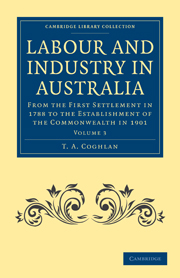 Labour and Industry in Australia
Labour and Industry in Australia XI - TRADE AND INDUSTRY
Published online by Cambridge University Press: 07 October 2011
Summary
When the census was taken in 1861 it was found that the population of the continent was 1,150,000, of whom more than one-fifth were located in Melbourne and Sydney. The external trade was valued at about £35,000,000, the imports being £17,600,000 and the exports £17,400,000. Gold was still the largest item of export, the value of coin and bullion sent away in 1861 being considerably more than half the total export; the balance comprised chiefly wool and other pastoral produce.
The production of gold began to decline after 1856, and grew less every year during the whole period, in spite of some important discoveries made in Queensland and in New South Wales. Gold-mining still maintained a position of importance in Victoria, but even there, at the middle of the period, the industry, measured by the value of its production, ranked below either agriculture or grazing. The value of gold won in all the colonies during 1861 was about £9,676,000; in 1872 it was £7,389,000; thence forward there was a rapid decline.
Copper and coal were the only other minerals raised in commercial quantities at the beginning of this period. South Australia had been very much helped by its copper industry in the days preceding the gold discoveries; but the immediate effect of those discoveries was, as we have seen, to deprive the Province of its able-bodied workers, especially its miners.
- Type
- Chapter
- Information
- Labour and Industry in AustraliaFrom the First Settlement in 1788 to the Establishment of the Commonwealth in 1901, pp. 1187 - 1205Publisher: Cambridge University PressPrint publication year: 2011First published in: 1918
